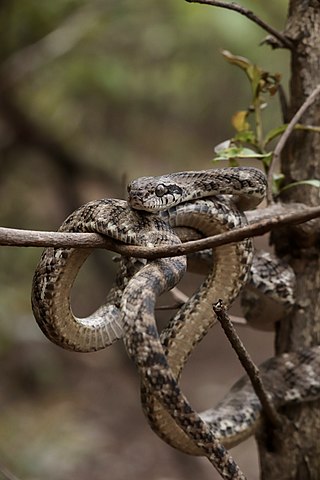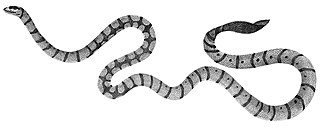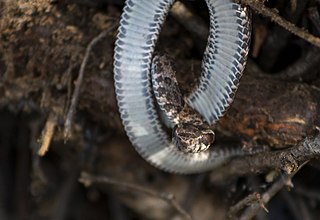
Boiga is a large genus of rear-fanged, mildly venomous snakes, known commonly as cat-eyed snakes or simply cat snakes, in the family Colubridae. Species of the genus Boiga are native to southeast Asia, India, and Australia, but due to their extremely hardy nature and adaptability, have spread to many other suitable habitats around the world. There are 38 recognized species in the genus. According to the study done by Jiří Smíd regarding Old World cat snakes, the ancestor of the cat snake originated in Africa, from where it diversified and expanded to other countries. Despite this diversity however, the different species have very similar needs in terms of temperature and precipitation.

The eastern green mamba is a highly venomous snake species of the mamba genus Dendroaspis native to the coastal regions of southern East Africa. Described by Scottish surgeon and zoologist Andrew Smith in 1849, it has a slender build with a bright green back and green-yellow ventral scales. Adult females average around 2 metres in length, and males are slightly smaller.

Ahaetulla nasuta, also known as Sri Lankan green vine snake and long-nosed whip snake, is a venomous, slender green tree snake endemic to Sri Lanka.

Boiga andamanensis, known commonly as the Andaman cat snake, is a species of rear-fanged snake in the family Colubridae. The species is endemic to the Andaman Islands.

Boiga ceylonensis is a species of rear-fanged, mildly venomous, nocturnal, arboreal colubrid snake endemic to Sri Lanka.

Boiga dendrophila, commonly called the mangrove snake or the gold-ringed cat snake, is a species of rear-fanged venomous snake in the family Colubridae. The species is endemic to southeast Asia. It is one of the biggest cat snake species, averaging 6–7 feet in length. It is considered mildly venomous. Although moderate envenomations resulting in intense swelling have been reported, there has never been a confirmed fatality.
Boiga dightoni, commonly known as Dighton's catsnake, the Pirmad cat snake, and the Travancore cat snake, is a species of rear-fanged mildly venomous snake in the family Colubridae. The species is endemic to the Southern Western Ghats of India.

Boiga forsteni, also known as Forsten's cat snake, is a species of mildly venomous rear-fanged colubrid endemic to South Asia.

The collared cat snake is a species of nocturnal, tree-dwelling, rear-fanged colubrid snake endemic to south India.

Hydrophis cyanocinctus, commonly called the annulated sea snake or the blue-banded sea snake, is a species of venomous sea snake in the family Elapidae.

Hydrophis spiralis, commonly known as the yellow sea snake, is a species of venomous sea snake in the family Elapidae.

Bungarus candidus, commonly known as the Malayan krait or blue krait, is a highly venomous species of snake. The blue krait is a member of the genus Bungarus and the family Elapidae.
Echis ocellatus, known by the common names West African carpet viper and ocellated carpet viper, is a highly venomous species of viper endemic to West Africa. No subspecies are currently recognized.
Causus maculatus is viper species found mainly in West- and Central Africa. No subspecies are currently recognized. Common names include forest rhombic night adder, West African night adder and spotted night adder. Like all other vipers, it is venomous.

Boiga nigriceps is a species of colubrid snake from South-East Asia. They are large snakes; adults may attain a total length of 1.75 m.

Bothrops bilineatus, also known as the two-striped forest-pitviper, parrotsnake, Amazonian palm viper, or green jararaca, is a highly venomous pit viper species found in the Amazon region of South America. Two subspecies are currently recognized, including the nominate subspecies described here. A pale green arboreal species that may reach 1 m (3.3 ft) in length, it is an important cause of snakebite throughout the entire Amazon region.

Bothrops erythromelas, commonly known as the Caatinga lancehead or the jararaca-da-seca, is a species of venomous snake in the family Viperidae. It is endemic to Brazil.

Aspidelaps lubricus, commonly known as the Cape coral snake or the Cape coral cobra, is a species of venomous snake in the family Elapidae. The species is endemic to southern Africa.

Boiga philippina, also known as the tawny cat eyed snake or Philippine cat snake, a species of rear-fanged colubrid snake that is endemic to the Philippines.

Boiga flaviviridis, the yellow-green cat snake, is a species of mildly venomous, rear-fanged snake of the family Colubridae, which is found in India. It is a rear fanged, nocturnal, arboreal species of snake that probably feeds on lizards, frogs and small birds. It was first described in 2013.





















